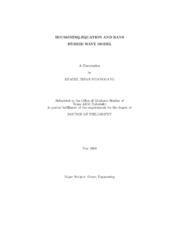| dc.description.abstract | This dissertation presents the development of a novel hybrid wave model, comprised
of the irrotational, 1-D horizontal Boussinesq and 2-D vertical turbulence-closed
Reynolds Averaged Navier-Stokes (RANS) wave models. The two constituents are
two-way coupled with the interface placed at a location where turbulence is relatively
small. Boundary conditions on the interfacing side of each model is provided by its
counterpart model through data exchange, requiring certain transformation due to
the difference in physical variables employed in both models. The model is intended
for large-scale wave simulation, accurate in both the nonbreaking and breaking zones
with relatively coarser grid in the former and finer in latter, and yet efficient.
Hybrid model tests against idealized solitary and standing wave motions and
wave-overtopping on structure exhibit satisfactory to very good agreement. Compared
with pure RANS simulations, the hybrid model saves computational time by
a factor proportional to the reduction in the size of the RANS domain. Also, a
large-scale tsunami simulation is provided for a numerical setup that is practically
unapproachable using RANS alone; not only does the hybrid model offer more rapid
simulation of relatively small-scale problems, it provides an opportunity to examine
very large total domains with the fine resolution typical of RANS simulations.
To allow for implementation on even larger domain with affordable CPU time, the hybrid model is parallelized to run on distributed memory machine. This is done
by parallelizing the RANS model while leaving the Boussinesq model serial. One
of the processors is responsible for both the sub-RANS and Boussinesq calculations.
ICCG(0) for solving the pressure equation is parallelized using the nonoverlappingdecomposition
technique, requiring more iterations than the serial one. Standing
wave and hypothetical tsunami simulations with 960×66 and 1000×100 grids, and
using 8 processors confirm model validity and computational efficiency of 82% and
65%.
Finally, the 2-D Boussinesq model is parallelized using domain decomposition
technique. The solution to the tridiagonal system arising in the model is calculated
as the sum of the homogeneous and particular solutions. Parallel model tests using
up to 32 processors exhibit model accuracy and efficiency of 80% for simulation with
500×500–2000×2000 grids. | en |


